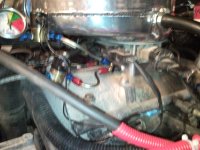Yesterday a 4.0L TB from a '98 Cherokee arrived by UPS -- to be installed on a 2000 2.5L TJ. With the help of a neighbor who teaches auto mechanics at the local high school (absolutely cool woman who decided to make it a day project for some of her students), I dyno-ed everything in stages. Checked the air flow, too.
Results, with stock (2.5L TB & no spacer)as baseline:
(1) Poweraid spacer only -- +2 HP, 8% less airflow (Evidently, the helix bore, lips of which extends beyond intake & TB opening, actually cuts down on airflow. But the spacer does "cool" and extend air volume, hence horsepower increase.)
(2) 4.0L TB only -- + 6 HP, 16% more airflow (no surprise here)
(3) 4.0L TB & grind out intake opening to match lower TB opening -- + 13 HP, 29% more airflow (Wow! Grinding out the intake opening did make a difference!)
(4) 4.0L TB & Poweraid helix spacer & grinded-out intake opening -- +16 HP, 2% less airflow from #3 above(overlapping helix bore is still cutting off airflow, but spacer is still cooling & increasing air volume)
(5) 4.0L TB & grind out helix bore in Poweraid spacer to match lower TB opening & grinded-out intake opening (the Big Kahuna) -- + 24 HP, 39% more airflow (Wow again; the optimal configuration, obviously)
It should be noted that grinding out the helix in the Poweraid spacer still leaves a partial helix in the walls -- the main difference being that the helix now has rounded edges rather than sharp ones. My auto mechanics-teacher neighbor suggests that these rounded edges are actually more aerodynamic than the original sharp ones, and will still "spin air" -- so perhaps the "pulse-organizing" effect I mentioned in an earlier post will be retained, if in fact there is such an effect.
So, to reiterate, I ground out on the helix bore of the Poweraid spacer, and ground out the intake opening, both to match the lower opening of the 4.0L TB I swapped in. Dyno-ed & tested airflow, results: +24 HP, 39% more airflow.
Seat-of-the-pants impression: idles smoothly, more torque on the low end, smoother accleration through the midrange, and better performance above 2700 RPM. No hesitation, no engine codes.
One MAJOR suggestion: if you grind out your intake opening, be VERY CAREFUL about aluminum filings in the intake manifold. We stuffed everything with tack cloth -- sticky cloths which can be purchased at a hardware store -- rather than shop towels. The tack cloth caught about 95% of the filings, but there was still a small mess in the intake. We vacuumed a lot of the leftover out with a shopvac, but we still had to use tack cloth attached to a long, thin screwdriver to "mop out" the runners. On the TJ there are also four open plugs/hoses attaching to the intake below the TB -- you'll have to clean those, too. It took longer to clean out the intake than it did to bore out the opening, but it can and needs to be done.
Finally, should say that the TJ has a two-stage K&N filter system, an MSD ignition system & coil, high-gapped Champion truck plugs, a Flowmaster delta-40 catback, and a case-full of Mobil 1 synthetic oil. All or part of which may have a synergistic effect on my results, since mods usually affect each other.
Cheers, GP
http://www.forumco.com/jeffy/topic.asp?TOPIC_ID=858&FORUM_ID=6&CAT_ID=1
More Info: (1) The intake is soft aluminum, so we used a medium tungsten rasp, followed by a fine fluted grinder bit, followed by a fine polisher. I'll admit it's not even -- hard to get consistency around the runner walls which are nearly flush to the intake opening. The spacer is a harder grade of metal, and trickier, even when clamped in a vise. Doesn't look pretty anymore, at least on the inside.
(2) Tested at 1800 RPM and 2800 RPM with an average between the two -- but the results were fairly similar.
(3) We figured the following: At 2800 RPM, torque was up by about 16% with #5 option above. At 1800 RPM, torque was up by about 14%.
Again, folks, consider the mods and the synergistic effects -- your numbers may be different depending on what you have your rig, mileage, mechanical conditions, altitude, etc. I give this just as a general indication.
Ambient air temperature: 74 degrees Humidity: about 35%

